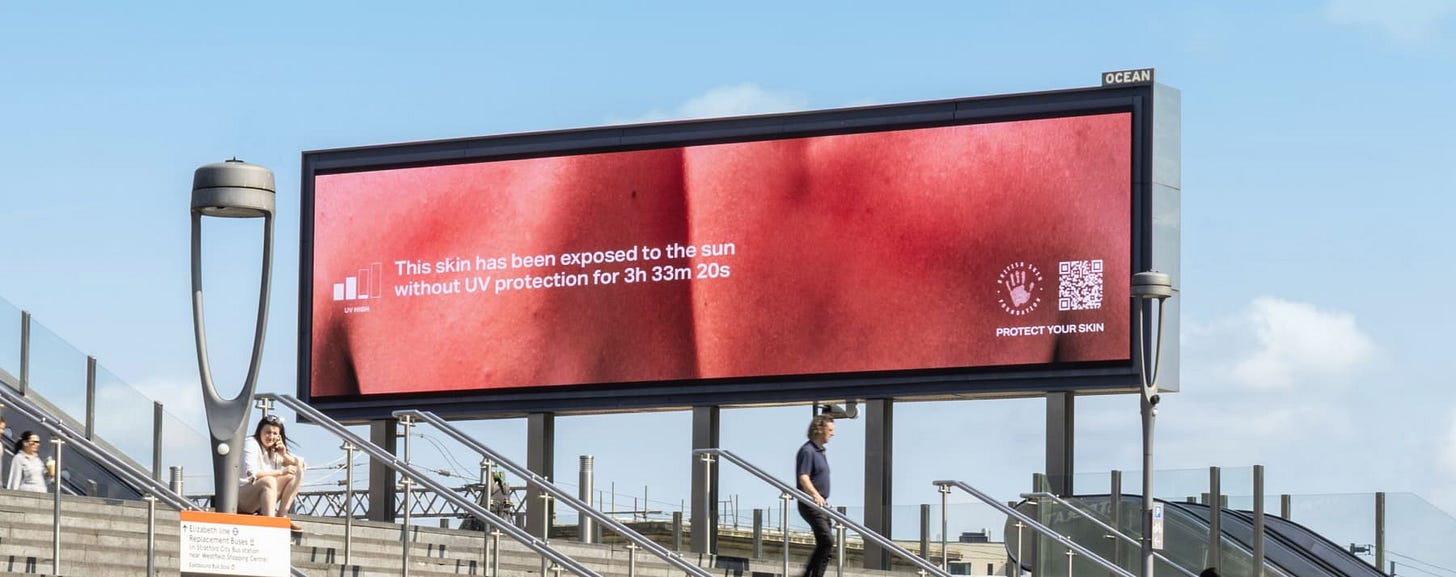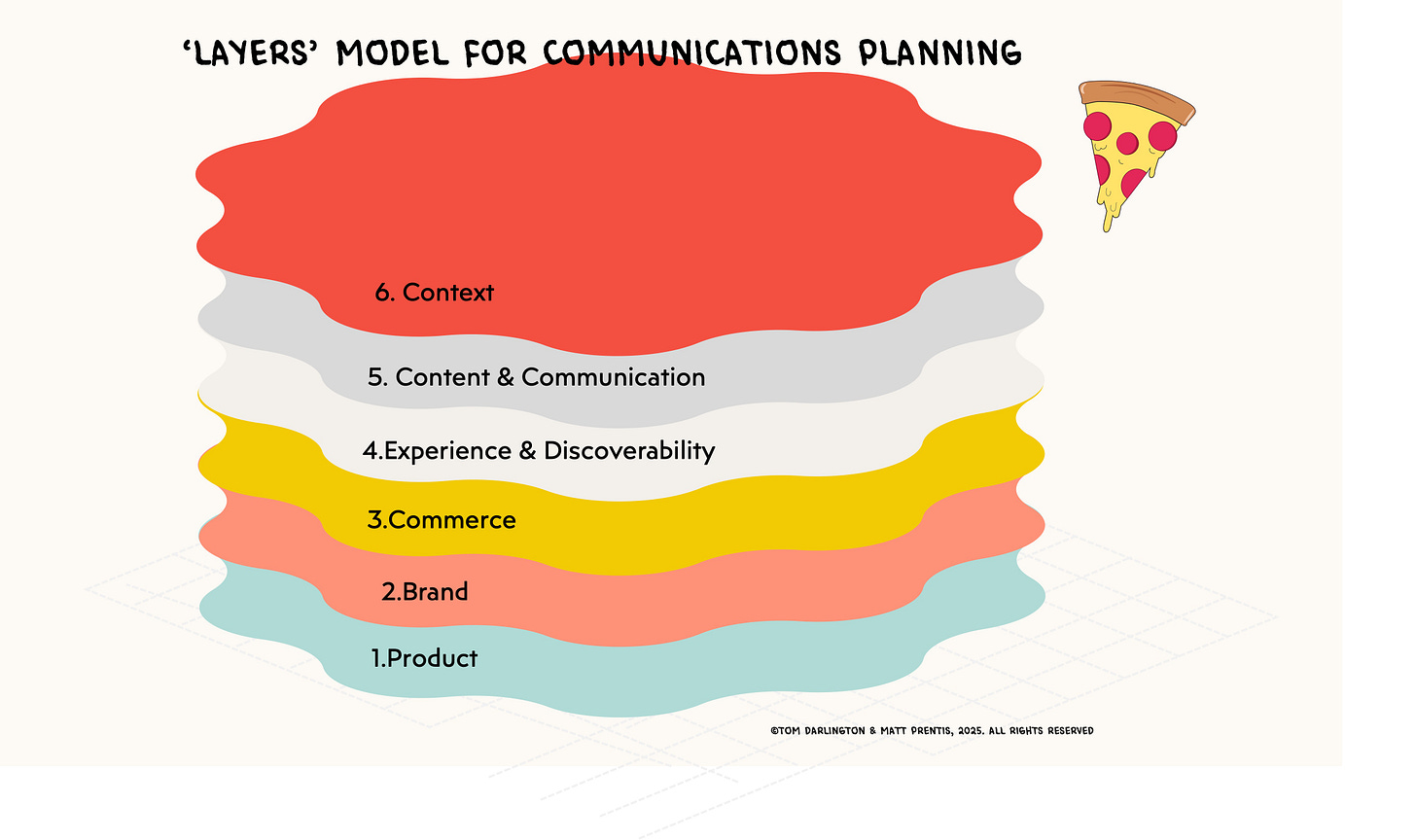Ideas We Love: Layers Not Channels
Issue Number 58: Sharing some thinking from the IWL whiteboard
Hi there. How are you?
Summer only officially started this weekend, but the last week has been super-super hot here in the UK. Unlike other parts of the world, our predominantly brick based housing stock and lack of AC means we’re not really set up to deal with exteme heat. Many of us (especially Tom) aren’t particularly well equipped to deal with the heat either: even with sun-screen he’s a “burner”.
One of the ideas we encountered this week illustrates the danger of unprotected exposure to the Sun to incredible effect. The Burning Billboard by Wonderhood Studios for The British Skin Foundation is a brilliant bit of modern communications thinking…. per to the press release, “Using Ocean’s live data feed technology, and API and data from weather sensors, the individual DOOH screens are updated with the exact UV level in that location in real time every second. Starting out with beautifully shot, close ups of healthy skin types and tones (pictured above), the higher the UV exposure, the more the skin begins to change, burn and eventually blister in real time (pictured below)”.
What a brilliantly simple and powerful idea. The campaign represents an incredibly potent mix of creative message, media format, data and technology in order to “provide the public with a powerful visual representation of the harm UV rays can inflict on the skin”. Burning Billboards marks a coming of age for Dynamic Creative Optimisation (DCO). This execution moves DCO on from simple signposting style activations (e.g where is the nearest beer garden) or from pragmattic, programmatic ad-serving…. Instead this is an idea that genuinely couldn’t have happened without the application of a dynamic layer of technology. It’s really good stuff, isn’t it?
The idea: Layers not Channels 🥞
It’s not often we write about one of our own ideas, but that’s what we’re going to explore today. One of the reasons we like Burning Billboards so much is that it’s a great example of an approach to planning that we like to say ‘thinks about layers, not channels’.
The origins of this idea stem from a conversation with a DCO specialist we worked with. For all the growth that this area of the industry was seeing, he suggested that his clients and partners were treating the capability as an isolated line item on the digital plan; little more than a media vendor that could be removed or exchanged from the plan with ease. DCO capability was being diminished by virtue of this treatment, he argued. It was seen as a nice to have and not an integrated component of the communications strategy.
Historically, when new forms of advertising have become available, the industry often thinks about them as facsimiles of more traditional, analogue media channels. The mental model for display advertising was outdoor; Search, was treated like a new form of classified advertising, eCommerce and Retail media at launch was compared to traditional POS communications.
But - Search isn’t just a media channel, it’s a consumer behaviour. eCommerce isn’t just a digital shelf-wobbler, shoppability is increasingly a way to shortcut or reduce friction in the consumer journey….
And so Dynamic advertising, instead of being used to eek out a few more basis points of performance from banners, could be reframed as something more powerful entirely. A contextual layer that sits over everything a brand does. A means by which a brand could, across all it’s touchpoints, ensure maximum relevance to the audience it is being presented to through the management and application of data signals.
Treating these technologies as channels limits the value they can play on the communication plan.
So, what if we stopped thinking about channels as the core component of the communications plan and started thinking in terms of the layers through which our ideas could live and breathe instead?
The model for thinking in layers we’ve been noodling with (above) consists of six layers (though you can play around with this subject the brand or project you’re working on)….
At the base of the model, which is our most fundamental layer, is Product: what a company produces and sells. Above this is Brand: the means by which a company brands it’s products: logos, colours, fonts, brand name, slogans.
The third layer up is Experience and Discoverability: A brand’s physical and digital presence - what the brand does and where it does it, in both the real and digital world. Discoverability includes what we might traditionally think of as ‘search’, sitting under this banner we might conceive of this less as ‘google’ and more as getting the brand listed in all environments where relevant search behaviour exists.
Next is Commerce: the ways and means by which a brand transacts with consumers beyond it’s own retail environments. This includes working with third party retailers and distributors, advertising within these retailers and new forms of ‘shoppable’ advertising format which shorten the distance between exposure and sale.
The penultimate layer is Content and Commmunication. What we would typically think of as brand advertising, focussed on building the top and middle of the brand funnel. The inclusion of content broadens the role of this layer beyond merely ATL and starts to make allowances for different types of content.
Last is Context: the levers by which a brand can flex it’s activity in content and communication such as audience and inventory availability related to specific content genres, or specific ‘contextual’ triggers like weather or stock availability.

Why we’re interested in this as a new mental model for communications planning 📡
When we think about things purely in channel terms - we run the risk of creating disjointed or loosely integrated activities which don’t capitalise on the full potential offered by martech innovation or ladder up to a coherent strategy. Something which is especially troublesome in the face of media fragementation.
In this model each layer builds on top of the one that came before, and whilst not all activities we undertake will need to use all layers (as brand and product may be locked) this does not mean we should be working in isolation of these factors. Similarly, for some brands or projects certain layers may not apply.
We believe the power of the model lies in how it encourages thinking that cascades upward and downward through the layers. It asks planners and strategists to make choices and build ideas through the lens of each layer. The abundance of data we now have in marketing can help provide the means of navigating and defining the role of each layer and act as a form of connective tissue.
There is an additive, multiplicative dynamic at play when building plans and generating ideas through the lens of this model. The more layers we can incorporate, the stronger the ideas we take to market.
‘Layers not Channels’ IRL: Cannes 2025 🦁
We promised you a Cannes wash up. Granted, this might not be the ‘greatest hits’ type post that you were hoping for, but Linkedin is awash with that kind of stuff. Instead, we thought it might be more interesting to look for evidence of ‘layered’ approaches to communications thinking in the crop of this year’s award winners.
#1. Vaseline Verified ✔️
The amazing thing about Vaseline is just how static the product is. It’s never changed in the entire time we’ve been conscious of brands. And that’s not particularly common. Even the humblest of FMCG brands will announce a new formula from time to time…. Vaseline realised their product was being used in a variety of ‘hacks’ - and set out to verify the ones that worked and warn against the ones that didnt… This idea builds from the product layer, but find it’s strength in the experience & discoverability layer by turning the hacks into social content, as well as the commerce layer through shoppable ads. Lovely.
#2. Penny Price Packs €
We wrote about this one in our D&AD wrap up in IWL#54. Probably one of our favourite things of the year. There is something so nice about this slow idea - it works across product, commerce and context layers. This won a Grand Prix in the Print and Publishing campaign and a total of nine Lions in all.
#3. Mercado Libre. Coupon Rain
Mercado Libre’s Coupon Rain is a perfect illustration of layered thinking. In the old world, this would be a press stunt. In the layered model? It’s a seamless blend of Context, Content, and Commerce.
#4. Skoda Octavia; The Redditor Edit
Škoda’s Redditor Edit is another textbook case of layered thinking in action.
What might once have been a digital “Reddit activation” became something far more potent; an act that started in the Reddit community, shaped product development, made its way into content and comms that went ATL; turning one of the UK’s most ‘boring’ cars into a cult hero along the way.
#5. Export Beer. Cold Call-Back. A Brand New Invention
Is a brilliant example of Content, Context & Experience working together to solve the real-world problem of exploding beer bottles (that have been left in the freezer too long when chilling them), in a playful way that helps Export position themselves as the go-to brand for cold, refreshing beer.
Using Vanilla Ice. Obvs.
Until Next Time
This week was a little bit different. We hope you enjoyed the issue and that you find a way to think about how you might use ‘layers’ rather than ‘channels’ on the next brief you work on.
Until next time. Cheerio
Tom & Matt x










